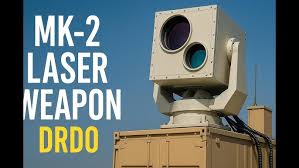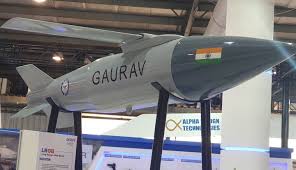My article published on The EurasianTimes website on 16 Apr 25.
India successfully tested its first high-energy laser weapon, the Mk-II(A) Laser-Directed Energy Weapon (DEW), on April 13, 2025, at the National Open Air Range in Kurnool, Andhra Pradesh. Developed by the Defence Research and Development Organisation (DRDO), the 30-kilowatt laser system demonstrated the ability to neutralise fixed-wing, swarm, and surveillance sensors precisely at ranges up to 5 kilometers. The weapon can engage targets at the speed of light, using a laser beam to cause structural failure or destroy warheads, offering a cost-effective alternative to traditional ammunition with minimal collateral damage.
The test places India among a select group of nations, including the US, China, and Russia, with advanced laser weapon capabilities. DRDO plans to induct the land-based system within two years, with future upgrades for greater range and applications on ships, aircraft, and satellites. A more powerful 300-kilowatt “Surya” laser capable of targeting high-speed missiles and drones up to 20 kilometers away. Posts on social media highlight the weapon’s potential to counter aerial threats effectively.
Directed Energy Weapons (DEWs) represent a transformative leap in military technology. They harness concentrated energy to neutralise threats with unprecedented precision and speed, a feat once only a part of science fiction. Unlike conventional munitions, which rely on physical projectiles or explosives, DEWs deliver energy through lasers, microwaves, or particle beams to disable or destroy targets.
Directed Energy Weapons
At their core, DEWs operate by focusing energy to create destructive effects. The most prominent type, laser-based DEWs, emit highly focused beams of light that travel at the speed of light (approximately 300,000 kilometers per second). When this beam strikes a target, it transfers intense heat, causing structural failure, melting critical components, or detonating warheads. For instance, India’s 30-kilowatt Mk-II(A) laser demonstrated its ability to neutralise drones and sensors up to 5 kilometers away by inducing catastrophic overheating in seconds.
Microwave-based DEWs, another category, emit electromagnetic pulses to disrupt or destroy electronic systems. These are particularly effective against swarms of drones or missile guidance systems, as they can disable multiple targets simultaneously within a wide area. Though less developed, particle beam weapons accelerate charged particles to damage targets at the molecular level, offering potential for future applications.
The advantages of DEWs are manifold. They require no physical ammunition, reducing logistical burdens and costs—engagements are estimated to cost mere dollars per shot compared to thousands for missiles. This cost-effectiveness is a significant advantage in modern warfare. Their speed-of-light delivery ensures near-instantaneous impact, critical for countering fast-moving threats like hypersonic missiles. Additionally, DEWs produce minimal collateral damage, making them ideal for precision strikes in populated areas.
Historical Context and Global Development
The concept of DEWs dates back to science fiction, with early inspirations from works like H.G. Wells’ War of the Worlds. However, serious development began during the Cold War, with the United States and Soviet Union exploring laser technologies for missile defence. This historical context provides a deeper understanding of the evolution of technology. The U.S. Strategic Defence Initiative in the 1980s, often dubbed “Star Wars,” aimed to deploy space-based lasers to intercept ballistic missiles, though technological limitations stalled progress.
In recent decades, advancements in power generation, beam control, and thermal management have brought DEWs closer to battlefield reality. The United States has led the charge, with systems like the Navy’s 150-kilowatt Laser Weapon System (LaWS) deployed on ships to counter drones and small boats. Israel’s Iron Beam, designed to complement the Iron Dome, uses lasers to intercept rockets and mortars cost-effectively. China and Russia have also invested heavily, with China’s Silent Hunter laser system reportedly capable of disabling vehicles and drones, and Russia’s Peresvet laser designed for air defence and satellite disruption. These developments can potentially reshape international relations as countries with advanced DEW capabilities gain new strategic advantages.
Applications in Modern Warfare
DEWs are poised to revolutionise defence across multiple domains. On land, they offer robust protection against drones, a growing threat in asymmetric warfare. The proliferation of low-cost drones, as seen in conflicts like Ukraine, has exposed vulnerabilities in traditional air defences. Laser systems provide a sustainable countermeasure with their low per-shot cost and unlimited “magazine” (limited only by power supply). For example, India’s Mk-II(A) successfully neutralised a swarm of drones, a capability critical for border security.
DEWs enhance naval defence against anti-ship missiles, small boats, and unmanned aerial vehicles at sea. The U.S. Navy’s High Energy Laser with Integrated Optical-Dazzler and Surveillance (HELIOS) system, integrated into destroyers, exemplifies this trend. For India, equipping warships with laser systems could strengthen maritime security in the Indian Ocean, a vital trade corridor.
In the air, DEWs are being developed for aircraft to counter incoming missiles. The U.S. Air Force’s Self-Protect High Energy Laser Demonstrator (SHiELD) aims to equip fighter jets with laser pods for missile defence. India’s vision to mount lasers on aircraft could enhance its air superiority, particularly against regional adversaries with growing missile arsenals.
Space-based DEWs, though controversial, represent the next frontier. Lasers could disable enemy satellites or defend against anti-satellite weapons, securing critical communication and reconnaissance assets. India’s planned satellite-mounted lasers underscore its intent to safeguard its space infrastructure.
Challenges and Limitations
Despite their promise, DEWs face significant hurdles. Atmospheric conditions like rain, fog, or dust can scatter or weaken laser beams, reducing their effectiveness. India’s DRDO addresses this through advanced beam control systems, but challenges persist in diverse terrains like the Himalayas. Power requirements also pose a barrier—high-energy lasers demand substantial electricity, necessitating compact, efficient generators. For mobile platforms, this remains a logistical challenge.
Cost and scalability are additional concerns. While DEWs are cheaper per shot, initial development and deployment costs are high. India’s Mk-II(A) required years of investment, and scaling to systems like the Surya laser will demand further resources. Finally, countermeasures like reflective coatings or electronic hardening could reduce DEW effectiveness, sparking an arms race in defensive technologies. It’s important to note that while DEWs offer significant advantages, they are not without vulnerabilities. Developing effective countermeasures will be a key area of focus in the future.
Future of Directed Energy Weapons
The global DEW market is expected to grow rapidly, fuelled by increasing threats from drones, missiles, and electronic warfare. India’s roadmap, which includes the induction of the Mk-II(A) by 2027 and the development of the Surya laser, positions the country as a key player. Collaborative efforts with allies could hasten progress, while indigenous innovation ensures strategic autonomy.
Beyond military applications, DEWs have the potential for civilian uses, such as removing space debris or disaster response (e.g., disabling hazardous objects). Their integration into multi-layered defence systems—combining lasers, missiles, and electronic warfare—will redefine warfare as technology matures.
Conclusion
Directed Energy Weapons mark a paradigm shift in defence, offering speed, precision, and economy unmatched by traditional systems. India’s successful test of the Mk-II(A) laser underscores its emergence as a technological power, capable of shaping the future of warfare. While challenges remain, the trajectory is clear: DEWs are not just the stuff of science fiction but a cornerstone of 21st-century security. As nations race to master this technology, the balance of power—and the ethics of its use—will shape the decades ahead.
Please Add Value to the write-up with your views on the subject.
For regular updates, please register your email here:-
Link to the article on the website:-
References and credits
To all the online sites and channels.
Pics Courtesy: Internet
Disclaimer:
Information and data included in the blog are for educational & non-commercial purposes only and have been carefully adapted, excerpted, or edited from reliable and accurate sources. All copyrighted material belongs to respective owners and is provided only for wider dissemination.
References: –
- DRDO Press Release. “Successful Test of Mk-II(A) Laser Directed Energy Weapon Conducted by DRDO.” April 13, 2025.
- Firstpost. (2025, April 13). India’s ‘Star Wars’ weapon! DRDO tests laser that melts aerial threats. https://www.firstpost.com/india/indias-star-wars-weapon-drdo-tests-laser-that-melts-aerial-threats-13834676.html
- India Today. (2025, April 13). DRDO tests laser-based weapon system. https://www.indiatoday.in/india/story/drdo-laser-weapon-system-destroys-drones-missiles-test-kurnool-andhra-pradesh-2527665-2025-04-13
- LiveMint. (2025, April 13). In a first, India shoots down drones with laser weapon. https://www.livemint.com/news/india/in-a-first-india-shoots-down-drones-with-laser-weapon-joins-elite-league-of-nations-watch-video-11742305443609.html
- NDTV. (2025, April 13). India’s first futuristic “Star Wars” laser weapon. https://www.ndtv.com/india-news/indias-first-futuristic-star-wars-laser-weapon-shoots-down-drone-swarm-5420597
- The Hindu. (2025, April 13). DRDO tests directed energy weapon system. https://www.thehindu.com/news/national/drdo-tests-directed-energy-weapon-system-that-can-disable-drones-missiles/article68989626.ece
- Gormley, Dennis M. Directed Energy Weapons: Technologies, Applications and Implications. RAND Corporation, 2000.
- Kopp, Carlo. “Directed-Energy Weapons: Physics of High-Energy Lasers (HELs).” Defence Today, vol. 6, no. 4, 2008.
- Freedberg, Sydney J. Jr. “Lasers, Railguns & Directed Energy: The Future of War?” Breaking Defence, 2017.
- Defence Update. “Directed Energy Weapons: Changing the Face of Modern Warfare.” 2024.
- and International Studies (CSIS). Directed Energy and the Future Battlefield. CSIS Report, 2023.




